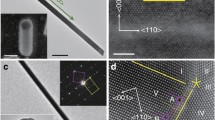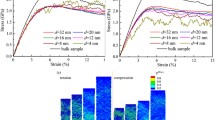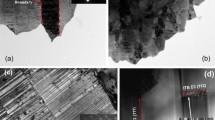Abstract
Penta-twinned Ag nanowires (pt-AgNWs) have recently attracted much attention due to their interesting mechanical and physical properties. Here we perform large-scale atomistic simulations to investigate the influence of sample size and strain rate on the tensile strength of pt-AgNWs. The simulation results show an apparent size effect in that the nanowire strength (defined as the critical stress for dislocation nucleation) increases with decreasing wire diameter. To account for such size effect, a theoretical model involving the interaction between an emerging dislocation and the twin boundary has been developed for the surface nucleation of dislocations. It is shown that the model predictions are in quantitative agreement with the results from atomistic simulations and previous experimental studies in the literatures. The simulations also reveal that nanowire strength is strain-rate dependent, which predicts an activation volume for dislocation nucleation in the range of 1–10\(b^{3}\), where b is the magnitude of the Burgers vector for a full dislocation.





Similar content being viewed by others
References
Xia, Y., Yang, P., Sun, Y., et al.: One-dimensional nanostructures: synthesis, characterization, and applications. Adv. Mater. 15, 353–389 (2003)
Lieber, C.M., Wang, Z.: Functional nanowires. MRS Bull. 32, 99–108 (2007)
Sun, Y., Gates, B., Mayers, B., et al.: Crystalline silver nanowires by soft solution processing. Nano Lett. 2, 165–168 (2002)
Sun, Y., Yin, Y., Mayers, B.T., et al.: Uniform silver nanowires synthesis by reducing AgNO\(_{3}\) with ethylene glycol in the presence of seeds and poly(vinyl pyrrolidone). Chem. Mater. 14, 4736–4745 (2002)
Zhu, Y., Qin, Q., Xu, F., et al.: Size effects on elasticity, yielding, and fracture of silver nanowires: in situ experiments. Phys. Rev. B 85, 045443 (2012)
Filleter, T., Ryu, S., Kang, K., et al.: Nucleation-controlled distributed plasticity in penta-twinned silver nanowires. Small 8, 2986–2993 (2012)
Narayanan, S., Cheng, G., Zeng, Z., et al.: Strain hardening and size effect in fivefold twinned Ag nanowires. Nano Lett. 15, 4037–4044 (2015)
Qin, Q., Yin, S., Cheng, G., et al.: Recoverable plasticity in penta-twinned metallic nanowires governed by dislocation nucleation and retraction. Nat. Commun. 6, 5983 (2015)
Cao, A., Wei, Y.: Atomistic simulations of the mechanical behavior of fivefold twinned nanowires. Phys. Rev. B 74, 214108 (2006)
Wu, J., Nagao, S., He, J., et al.: Role of fivefold twin boundary on the enhanced mechanical properties of fcc Fe nanowires. Nano Lett. 11, 5264–5273 (2011)
Yoo, J.H., Oh, S.I., Jeong, M.S.: The enhanced elastic modulus of nanowires associated with multitwins. J. Appl. Phys. 107, 094316 (2010)
Niekiel, F., Spiecker, E., Bitzek, E.: Influence of anisotropic elasticity on the mechanical properties of fivefold twinned nanowires. J. Mech. Phys. Solids 84, 358–379 (2015)
Zhang, S., Wang, Y.: Molecular dynamics simulation of tension-compression asymmetry in plasticity of fivefold twinned Ag nanopillars. Phys. Lett. A 379, 603–606 (2015)
Plimpton, S.: Fast parallel algorithms for short-range molecular dynamics. J. Comput. Phys. 117, 1–19 (1995)
Parrinello, M., Rahman, A.: Polymorphic transitions in single crystals: a new molecular dynamics method. J. Appl. Phys. 52, 7182 (1981)
Nose, S.: A unified formulation of the constant temperature molecular dynamics methods. J. Chem. Phys. 81, 511–519 (1984)
Williams, P.L., Mishin, Y., Hamilton, J.C.: An embedded-atom potential for the Cu–Ag system. Modell. Simul. Mater. Sci. Eng. 14, 817 (2006)
Tsai, D.: The virial theorem and stress calculation in molecular dynamics. J. Chem. Phys. 70, 1375–1382 (1979)
Faken, D., Jónsson, H.: Systematic analysis of local atomic structure combined with 3D computer graphics. Comput. Mater. Sci. 2, 279–282 (1994)
Li, D., Wang, F., Yang, Z., et al.: How to identify dislocations in molecular dynamics simulations? Sci. China Phys. Mech. Astron. 57, 2177–2187 (2014)
Chang, T., Cheng, G., Li, C., et al.: On the size-dependent elasticity of penta-twinned silver nanowires. Extreme Mech. Lett. 8, 177–183 (2016)
Jing, G., Duan, H., Sun, X., et al.: Surface effects on elastic properties of silver nanowires: contact atomic-force microscopy. Phys. Rev. B 73, 235409 (2006)
McDowell, M.T., Leach, A.M., Gall, K.: On the elastic modulus of metallic nanowires. Nano Lett. 8, 3613–3618 (2008)
Chen, Z., Jin, Z., Gao, H.: Repulsive force between screw dislocation and coherent twin boundary in aluminum and copper. Phys. Rev. B 75, 212104 (2007)
Deng, C., Sansoz, F.: Repulsive force of twin boundary on curved dislocations and its role on the yielding of twinned nanowires. Scr. Mater. 63, 50–53 (2010)
Gao, H., Rice, J.R.: Application of 3D weight functions II: the stress field and energy of a shear dislocation loop at a crack tip. J. Mech. Phys. Solids 37, 155–174 (1989)
Asaro, R.J., Suresh, S.: Mechanistic models for the activation volume and rate sensitivity in metals with nanocrystalline grains and nano-scale twins. Acta Mater. 53, 3369–3382 (2005)
Zhang, Y., Wang, T., Chen, X.: Effect of surface stress on the asymmetric yield strength of nanowires. J. Appl. Phys. 103, 123527 (2008)
Yang, Z., Lu, Z., Zhao, Y.: Atomistic simulation on size-dependent yield strength and defects evolution of metal nanowires. Comput. Mater. Sci. 46, 142–150 (2009)
Wei, Y.: Anisotropic size effect in strength in coherent nanowires with tilted twins. Phys. Rev. B 84, 014107 (2011)
Zhu, T., Li, J., Samanta, A., et al.: Temperature and strain-rate dependence of surface dislocation nucleation. Phys. Rev. Lett. 100, 025502 (2008)
Zhou, Q., Xie, J.Y., Wang, F.: The mechanical behavior of nanoscale metallic multilayers: A survey. Acta Mech. Sin. 31, 319–337 (2015)
Acknowledgements
The project was supported by the National Natural Science Foundation of China (Grants 11372152 and 51420105001) and the National Natural Science Foundation of United States (Grant CMMI-1161749). The simulations were performed on the TianHe-1 supercomputer at the National Supercomputer Center in Tianjin.
Author information
Authors and Affiliations
Corresponding authors
Appendix
Appendix
Here we calculate the normal distance x from point C to twin plane ABD in Fig. 6. Triangle DBC is one fifth the size of a regular pentagon on the [110] plane. Triangles ABD and ACD are on two twin planes, while triangle ABC is a dislocation slip plane. As illustrated in Fig. 6, we can calculate the area of triangle ABC in two ways:
Note the following expression,
Combining Eqs. (A1) and (A2), we obtain \(2x=\eta D\), where \(\eta \) is expressed as
Give that \(\theta =72.0{^{\circ }}\) and \(\beta =35.2{^{\circ }}\), then \(\eta =1.01\).
Rights and permissions
About this article
Cite this article
Zhang, X., Li, X. & Gao, H. Size and strain rate effects in tensile strength of penta-twinned Ag nanowires. Acta Mech. Sin. 33, 792–800 (2017). https://doi.org/10.1007/s10409-017-0675-6
Received:
Revised:
Accepted:
Published:
Issue Date:
DOI: https://doi.org/10.1007/s10409-017-0675-6





